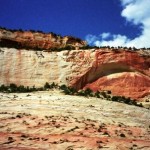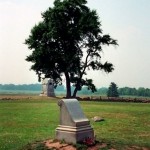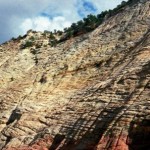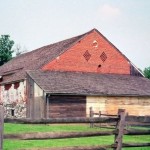More Zion Scenery: Zion National Park, September 2001 I shot this somewhere along the Zion—Mount Carmel Highway. (via Robby Edwards’ Photos)
Category Archives: Uncategorized
Knowledge Problem: How Competitive Is Coal-To-Liquids Conversion?
Terry Heaton’s PoMo Blog » Blog Archive » Court decision strengthens aggregators
Preservation Online: Tenn. Group Slowly Repairing Airplane Gas Station
“Give them the cold steel!”: Gettysburg National Military Park, June 2001 On our way to visit Rachelle’s brother in New York during the summer of 2001, Rachelle had to spend a day at a facility near Gettysburg for work. I took the opportunity to spend the day driving around the battlefield at Gettysburg National Military Park after I had dropped her off. For three days Union and Confederate forces fought in and around the small town of Gettysburg, PA. The Army of Northern Virginia, led by General Robert E. Lee, was marching through Pennsylvania. Only the Army of the Potomac stood between Lee and the Union capital, Washington D.C. The two armies clashed just outside of Gettysburg beginning on July 1, 1863. After two days of fierce fighting, Lee decided to attack the center of the Union line believing it to be the weakest part of the Union forces. This assault would be remembered as Pickett’s Charge. It began with a barrage of cannon fire from the Confederate side. Immediately, Union cannons returned fire. Both sides continued to fire for two hours. It was so heavy and loud that it was heard as far away as Pittsburgh (180 miles). When the Confederate cannon fire lifted, Lee-believing that the Union line to be softened up-ordered his troops to advance. To get to the Union forces, Confederate troops had to march almost one mile across an open field. As the Confederate troops marched toward the Union forces, Union cannons began to fire upon them. As the Union cannon fire decimated the Confederate lines, the Confederate soldiers closed ranks and continued to march toward the Union line. Union soldiers had taken cover behind a low stone wall, using it for cover while firing at the approaching soldiers. As the Confederate soliers approached the stone wall, Union troops had to abandon it. The Confederates now had the advantage of cover and began to return fire from the relative safety of the stone wall. But if the Confederate Army was to carry the day, it would have to go beyond this point, breaking the Union line and dividing the Army of the Potomac in half. Recognizing this, Confederate Genreral Lewis Armistead lead his troops over the stone wall crying, “Give them the cold steel!” This photo shows the monument which markes the spot where Armistead was mortally wounded. Behind it the single tree marks a spot where the stone wall abruptly turns. Known as “the Angle”, this is the spot where the Confederate Army crossed the wall and broke into the Union lines. To repulse the advancing Confederate troops, Union gun crews used special cannisters which turned their cannons into large shotguns. Desperately, Confederate forces tried to force their way forward, but Union soldiers held their ground. The Confederate soldiers, who had suffered so much and marched so far, were forced to retreat. This is where the battle would end. Known as the “High Water Mark”, it signifies the depest advance of the Confederate Army in the Civil War. Never again would Confederate forces threaten Union territory. Because of the large number of casualties inflicted upon the Army of Northern Virginia, Lee could not continue the fight. His withdrawal from Gettysburg began the next day. The Civil War would continue for another two years, during which the Confederate army was forced to fight a defensive war. (via Robby Edwards’ Photos)
Erosion Does Its Dirty Work: Zion National Park, September 2001 Our next activity was to drive along the Zion—Mount Carmel Highway. A portion of the highway passes through a 1.1-mile long tunnel that was built in the 1920s. Alongside this road are some of the tallest sandstone cliffs in the world. Wind and water cut perpendicular grooves into the surface of the sandstone of Checkerboard Mesa. (via Robby Edwards’ Photos)
Checkerboard Mesa: Zion National Park, September 2001 Our next activity was to drive along the Zion—Mount Carmel Highway. A portion of the highway passes through a 1.1-mile long tunnel that was built in the 1920s. Alongside this road are some of the tallest sandstone cliffs in the world. Wind and water cut perpendicular grooves into the surface of the sandstone of Checkerboard Mesa. (via Robby Edwards’ Photos)
They didn’t study
‘Cataracts the key to Monet’s blurry style’ | Uk News | News | Telegraph
A Scar of Battle: Gettysburg National Military Park, June 2001 On our way to visit Rachelle’s brother in New York during the summer of 2001, Rachelle had to spend a day at a facility near Gettysburg for work. I took the opportunity to spend the day driving around the battlefield at Gettysburg National Military Park after I had dropped her off. For three days Union and Confederate forces fought in and around the small town of Gettysburg, PA. The Army of Northern Virginia, led by General Robert E. Lee, was marching through Pennsylvania. Only the Army of the Potomac stood between Lee and the Union capital, Washington D.C. The two armies clashed just outside of Gettysburg on July 1, 1863. And would fight for another two days until Lee retreated after having suffered grievous casualties attempting to break the Union lines. The battle affected the citizens of Gettysburg. Even though there was only one civilian casualty, the town, as well as the nation, would be changed forever as a result. Evidence of the battle still exists in the Park. This photo is of the barn located on the Trostle Farm. In its wall can be seen a scar from the battle that was fought here. A hole from a cannonball remains 138 years after the battle was fought. (via Robby Edwards’ Photos)




